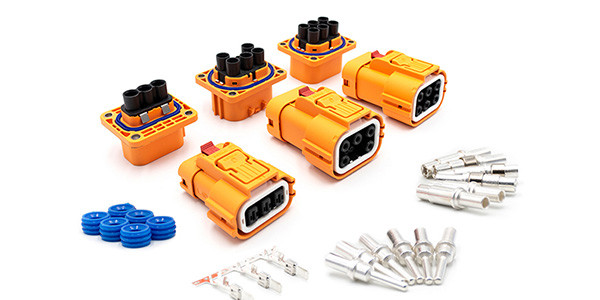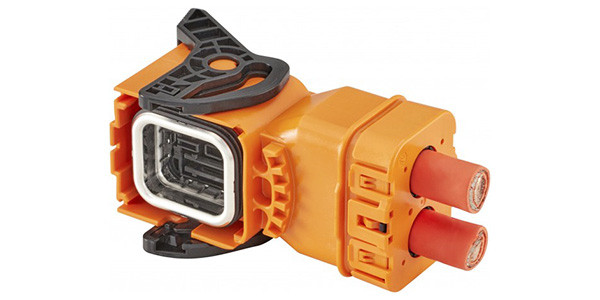Automotive High-Voltage Connectors
A Comprehensive Exploration
Automotive High-Voltage Connectors: A Comprehensive Exploration

The automotive industry is undergoing a profound transformation with the rise of electric vehicles (EVs) and hybrid electric vehicles (HEVs). At the heart of this shift are high-voltage electrical systems that power electric motors, batteries, and other critical components. Central to the functionality and safety of these systems are automotive high-voltage connectors. These specialized components are engineered to manage voltages typically ranging from 200V to 800V or higher, far surpassing the 12V or 48V systems of traditional internal combustion engine vehicles.
Table of Contents
ToggleIntroduction to High-Voltage Systems in Vehicles
The advent of EVs and HEVs marks a significant departure from conventional automotive engineering. Unlike traditional vehicles that rely on low-voltage systems for auxiliary functions, electrified vehicles utilize high-voltage architectures to deliver the power needed for propulsion and energy storage. High-voltage systems, typically defined in automotive contexts as operating above 60V, offer advantages such as improved energy efficiency, reduced current requirements (which minimize wiring size and weight), and enhanced performance.
Automotive high-voltage connectors are pivotal in these systems, facilitating the secure and efficient transfer of electrical power between components like the battery pack, inverter, electric motor, and charging infrastructure. Their importance has grown alongside the global push for sustainable transportation, driven by environmental regulations, consumer demand, and advancements in battery technology. These connectors must meet stringent requirements for electrical performance, safety, and durability, distinguishing them from standard automotive connectors used in low-voltage applications.
The evolution of high-voltage connectors mirrors the development of electric vehicles themselves. Early electric cars from the late 19th and early 20th centuries operated with rudimentary electrical systems and lower voltages. However, as battery technology progressed and the demand for higher power intensified, modern EVs—like the GM EV1 in the 1990s and today’s mainstream models—adopted higher voltage systems, necessitating specialized connectors. Today, these components are standardized and integral to the electrification revolution.
This article provides a detailed examination of automotive high-voltage connectors, offering insights into their role, engineering challenges, and future potential in the automotive landscape.
What Are Automotive High-Voltage Connectors?
Automotive high-voltage connectors are electromechanical devices designed to establish and maintain secure electrical connections within a vehicle’s high-voltage system. Their primary function is to transmit electrical power efficiently while preventing faults such as short circuits, arcing, or overheating, which could compromise safety or performance.
Key Characteristics
High-voltage connectors are distinguished by several critical attributes:
- High Voltage Rating: Designed to handle voltages from 200V to 1000V or more, depending on the system architecture.
- High Current Capacity: Capable of carrying currents from tens to hundreds of amperes to support motor operation and battery charging.
- Robust Insulation: Employs advanced materials to prevent electrical breakdown and ensure safety.
- Environmental Sealing: Features seals to protect against moisture, dust, and contaminants, ensuring reliability in harsh conditions.
- Mechanical Durability: Engineered to withstand vibrations, thermal cycling, and mechanical shocks typical in automotive environments.
- Safety Features: Includes mechanisms like interlocking systems, touch-safe designs, and color-coding to mitigate risks.
Applications
These connectors are deployed across various high-voltage circuits, including:
- Battery Pack Connections: Linking battery modules to the power distribution system.
- Inverter to Motor Connections: Transmitting power from the inverter to the electric motor.
- Charging Port Connections: Facilitating energy transfer from external chargers.
- DC-DC Converter Connections: Managing power conversion between high and low-voltage systems.
- HVAC Systems: Powering heating, ventilation, and air conditioning in some designs.
Each application demands connectors tailored to specific electrical, mechanical, and environmental requirements, making them a cornerstone of modern vehicle electrification.
Types of Automotive High-Voltage Connectors
The diversity of high-voltage applications in vehicles has led to the development of various connector types, categorized by their function and physical design.

By Application
- Battery Connectors
- Purpose: Connect the battery pack to the vehicle’s power distribution system.
- Characteristics: Must handle the full voltage and current of the battery (e.g., 400V and 400A in peak conditions). Often multi-pole to accommodate positive and negative terminals, plus sensing or communication pins.
- Example: Connectors in a Tesla Model 3 battery pack.
- Charging Connectors
- Purpose: Interface between the vehicle and external charging stations.
- Standards:
- CCS (Combined Charging System): Combines AC and DC charging; prevalent in Europe and North America.
- CHAdeMO: A Japanese DC fast-charging standard.
- GB/T: China’s standard for AC and DC charging.
- Tesla Supercharger: Proprietary, though transitioning to CCS in some markets.
- Characteristics: Designed for high power (e.g., 350A for fast charging).
- Motor Connectors
- Purpose: Link the inverter to the electric motor.
- Characteristics: High current capacity and electromagnetic interference (EMI) shielding to protect sensitive electronics.
- Power Distribution Connectors
- Purpose: Route power within the high-voltage distribution box to components like the onboard charger or HVAC.
- Characteristics: Multi-circuit designs with high reliability.
By Physical Design
- Circular Connectors: Robust, sealed, and often feature threaded or bayonet coupling. Common in automotive applications for durability.
- Rectangular Connectors: Offer higher pin density or fit constrained spaces.
- Custom Connectors: Proprietary designs tailored to specific vehicle architectures.
Voltage-Specific Designs
With the emergence of 800V systems (e.g., Porsche Taycan), connectors are evolving to support higher voltages, enhancing charging speed and efficiency while maintaining safety and compatibility.
Design Considerations for High-Voltage Connectors
Designing automotive high-voltage connectors involves addressing multiple engineering challenges to ensure performance, safety, and longevity.
1. Electrical Insulation
- Challenge: Prevent breakdown at high voltages.
- Solution: Use materials with high dielectric strength (e.g., PEEK, ceramics) and ensure adequate creepage and clearance distances to avoid arcing.
2. Current Carrying Capacity
- Challenge: Transmit high currents without excessive heat or voltage drop.
- Solution: Employ low-resistance copper alloys and optimize contact design (e.g., multiple contact points, high contact force).
3. Thermal Management
- Challenge: Dissipate heat from electrical resistance.
- Solution: Incorporate heat-conductive materials, larger surface areas, or cooling channels in advanced designs.
4. Mechanical Durability
- Challenge: Endure vibrations, shocks, and mating cycles.
- Solution: Use high-strength housings (plastic or metal) and vibration-resistant locking mechanisms.
5. Environmental Sealing
- Challenge: Protect against water, dust, and chemicals.
- Solution: Achieve high IP ratings (e.g., IP67) with gaskets or overmolding.
6. EMI Shielding
- Challenge: Minimize interference with vehicle electronics.
- Solution: Use metal shells, conductive coatings, or additional shielding layers.
7. Size and Weight Optimization
- Challenge: Reduce mass and volume for vehicle efficiency.
- Solution: Employ lightweight materials and compact layouts.
8. User-Friendliness
- Challenge: Ensure easy mating/unmating, especially for charging.
- Solution: Include ergonomic grips, self-aligning features, and visual feedback.
These considerations require a multidisciplinary approach, integrating electrical, mechanical, and materials engineering to meet automotive demands.
Safety Aspects of High-Voltage Connectors
Safety is paramount in automotive high-voltage connectors, given the risks posed by high-voltage electricity.

Key Safety Features
- Interlocking Mechanisms
- Prevents disconnection under load using mechanical levers or electrical pilot signals (e.g., in charging systems).
- Touch-Safe Designs
- Recessed contacts and insulating barriers ensure live parts are inaccessible.
- Color-Coding
- Orange coloring alerts technicians to high-voltage presence.
- Shielding and Grounding
- Metal shields and grounding paths reduce shock risk and contain EMI.
- Overcurrent Protection
- System-level fuses or circuit breakers; some connectors include sensors or fusible links.
Fault Tolerance
Connectors are designed to withstand short circuits or faults without igniting or releasing hazardous materials, enhancing overall vehicle safety.
Manufacturing and Materials
The production of automotive high-voltage connectors relies on advanced materials and precision manufacturing.
Materials
- Contacts: Copper alloys (e.g., brass, beryllium copper) with silver or gold plating for conductivity and corrosion resistance.
- Insulators: High-performance plastics (e.g., PEEK, PA66) or ceramics for dielectric strength and thermal stability.
- Housings: Reinforced plastics or aluminum for strength and shielding.
- Seals: Silicone or rubber for environmental protection.
Manufacturing Processes
- Molding: Injection molding for plastic parts with tight tolerances.
- Metalworking: Stamping or machining for contacts.
- Plating: Electroplating for surface finishes.
- Assembly: Automated lines ensure precision and cleanliness.
- Quality Control: Hi-pot testing, dimensional checks, and environmental simulations.
These processes ensure connectors meet the rigorous demands of automotive applications.
Testing and Standards
Automotive high-voltage connectors must adhere to strict standards and undergo comprehensive testing.
Standards
- ISO 17409: Safety requirements for EV high-voltage systems.
- SAE J1772: North American EV charging connector standard.
- IEC 62196: International standard for EV charging connectors.
- UL 2251: Safety standard for EV plugs and couplers.
Testing
- Electrical: Voltage withstand, insulation resistance, contact resistance.
- Mechanical: Mating cycles, vibration, shock.
- Environmental: Temperature cycling, humidity, salt spray.
- Safety: Touch safety, interlock functionality.
These protocols ensure reliability and compliance with global automotive standards.
Future Trends and Developments
The future of automotive high-voltage connectors is shaped by technological and industry trends.
1. Higher Voltage Systems
- Transition to 800V+ architectures for faster charging and efficiency, requiring advanced insulation and design.
2. Integration and Miniaturization
- Combining connectors with sensors or electronics to save space and weight.
3. Wireless Charging
- May reduce reliance on physical charging connectors, though internal connectors remain essential.
4. Standardization
- Efforts to unify connector designs globally for cost and compatibility benefits.
5. Advanced Materials
- Exploration of superconductors or composites for enhanced performance.
6. Smart Connectors
- Integration of diagnostics or communication features for monitoring and maintenance.
These advancements will ensure high-voltage connectors evolve with the needs of electrified vehicles.
Conclusion
Automotive high-voltage connectors are vital to the electrification of transportation, enabling the safe and efficient operation of EVs and HEVs. From their diverse types and meticulous design to their rigorous safety features and testing, these connectors embody the engineering excellence driving the automotive industry forward. As technology advances, innovations in voltage levels, materials, and integration will further enhance their role, supporting the shift toward sustainable mobility. Understanding these components highlights their critical contribution to the safety, efficiency, and future of modern vehicles.
